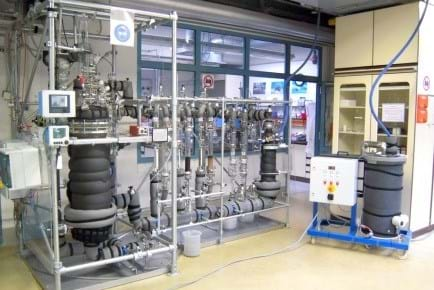Siempelkamp develops new process for nuclear decontamination

A PROCESS for the chemical decontamination of nuclear reactor cooling systems has been developed by Germany’s Siempelkamp NIS Ingenieurgesellschaft, which improves safety for workers and allows for metals to be recycled.
After the Fukushima disaster in Japan in 2011, Germany began decommissioning its nuclear facilities; decontaminating the cooling systems is a necessary step before plants can be decommissioned.
When a nuclear power plant is operating, protective oxidic coatings are formed on the inner surfaces of pipelines and components, but radionuclides also become incorporated in the oxide. The aim of Siempelkamp’s “advanced system decontamination by oxidising chemistry” (ASDOC) is to dissolve the oxide coating and remove the radionuclides.
Siempelkamp uses a combination of known and freely-accessible process chemicals to create a solution that dissolves the oxides. After preliminary tests, the procedure was modified to add an acid in order to stabilise the pH and prevent the solution from precipitating. Stabilising the pH is essential so that corrosion doesn't occur in weaker metals. This modified procedure is known as ASDOC_D-MOD.
The chemical decontaminant is added to the cooling system via the plant's existing facilities and the radionuclides are removed using ion exchangers. Using the on-site facilities negates the need for any external decontamination equipment to be erected inside radiation fields. As the system doesn't need to be opened, the danger of leakages is also reduced, and only a small amount of waste is produced.
The ASDOC_D-MOD procedure reduces the contamination by a factor of 85, which minimises the exposure of personnel dismantling power plant systems. The contamination of the metal surfaces is also lowered enough that it can be recycled or melted.
Aldo Weber, spokesperson for Siempelkamp NIS Ingenieurgesellschaft said: “The development of the procedure was very complex and a highly technical and scientific challenge. We suffered some setbacks until we arrived at the point where we could successfully demonstrate the practical use of it, which to date we have done twice.”
Siempelkamp successfully used the ASDOC_D-MOD procedure to decontaminate unit A at the Biblis nuclear power plant in Hesse, Germany, in late 2016, and completed decontamination of unit B in January 2018.
Recent Editions
Catch up on the latest news, views and jobs from The Chemical Engineer. Below are the four latest issues. View a wider selection of the archive from within the Magazine section of this site.




